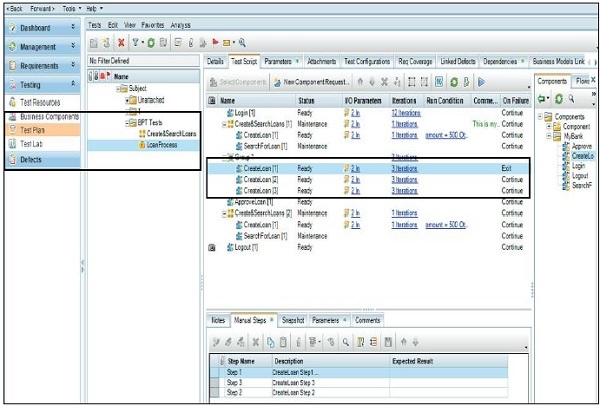
- SAP Testing Tutorial
- SAP Testing - Home
- SAP Testing - Overview
- SAP Testing - Types
- SAP Testing - Manual & Automation
- SAP Testing - SDLC
- Testing Type in SAP
- SAP Testing - Process
- SAP Testing - Navigation
- SAP Testing - Screen Flow
- SAP Testing - Modules
- SAP Testing - Interfaces
- SAP Testing - Cases
- SAP Testing - TAO
- SAP Testing - TAO Folder Structure
- Configure Quality Testing Center
- SAP Testing - TAO Results Analysis
- TAO Build & Execute Test Script
- SAP Testing - TAO Consolidate
- SAP Testing - TAO UI Scanner
- SAP Testing - Automation Tools
- SAP Testing - Solution Manager
- SAP Testing - HP Business Process
- SAP Testing - QTP
- SAP Testing - Case Study
- SAP Testing Useful Resources
- SAP Testing - Questions & Answers
- SAP Testing - Quick Guide
- SAP Testing - Useful Resources
- SAP Testing - Discussion
SAP Testing - HP Business Process
Business Process Testing (BPT) is a part of QTP automation framework and is used with the Quality Center by HP. BPT is used to create automation test scenarios and run those scenarios without any prior knowledge of automation.
HP BPT removes the complexity of test-case creation and maintenance and combines all the documentation and test automation in one effort.
Business Process Testing aligns the testing process with business goals and reduces the testing lifecycle time considerably.
How to Use HP Business Process Testing Tool?
Business Process Testing tool uses reusable components for creating test-cases and hence reduces the testing maintenance time and increases the efficiency of testing process.
To fasten the process of test automation, it uses the method of keyword driven. You can add common best practices to the testing process. It allows you to use a test solution which is not based on test scripts. Once a manual test is created in BPT, you can easily automate the test-case.

You can also maintain different versions and baseline for different test components, process flows without any chance of overwriting the old cases.
Test cases that are created using Business Process Testing tool can be executed using HP Quality Center QC.
Benefits of Using HP Business Process Testing
Using BPT, a non-technical SME can easily create, maintain, and run the test-cases and can document them in a Web-based system.
It allows you to design and create the reusable components in test-cases and use them as per the business requirements.
You can also run testing scripts using HP Sprinter.
With the availability of framework to use reusable components, it decreases the effort for maintaining the test-cases.
HP Quality Center (ALM)
HP Quality Center, a test management tool, is now popularly known as Application Life Cycle Management (ALM) tool, as it is no longer just a test management tool but it supports various phases of the software development life cycle.
HP-ALM helps us to manage project milestones, deliverables, resources and keeping track of project health, standards that allow Product owners to gauge the current status of the product. It is important to understand history, architecture, and Quality Center Workflow.
The Requirements module enables users to define, manage and track requirements at all stages of the software lifecycle. The following are the key functionalities in requirements module.
| S.No. | Functionality & Description |
|---|---|
| 1 | Creating Requirements
Create requirements, assign to releases/cycles. |
| 2 | Uploading Requirement
Uploading requirements using ALM-MS Excel Add-ins |
| 3 | Requirement Traceability
Enables how to define traceability links between requirements and dependencies that exist between the requirements. |
| 4 | Traceability Matrix
Enables user to view the traceability matrix that lists source requirements and their associated requirements and tests. |
Test Plan
The crucial step in testing any application is to develop a clear and a precise test plan. A good test plan enables the team to assess the quality of the application under test at any point in the software development life cycle.
Following functionalities are very important in order to understand the test plan module better.
| S.No. | Functionality & Description |
|---|---|
| 1 | Creating Tests This module describes how to create folders of test subjects in the test plan tree and also to add tests. |
| 2 | Uploading Tests Uploading Teats using ALM-MS Excel Addins |
| 3 | Requirement and Test Coverage Enable how to define the relationship between the requirements and tests. |
| 4 | Test Configuration Specific the subset of data or a run-time environment that the test should use. |
More details on how HP QC, please go to − http://www.tutorialspoint.com/qc/index.htm